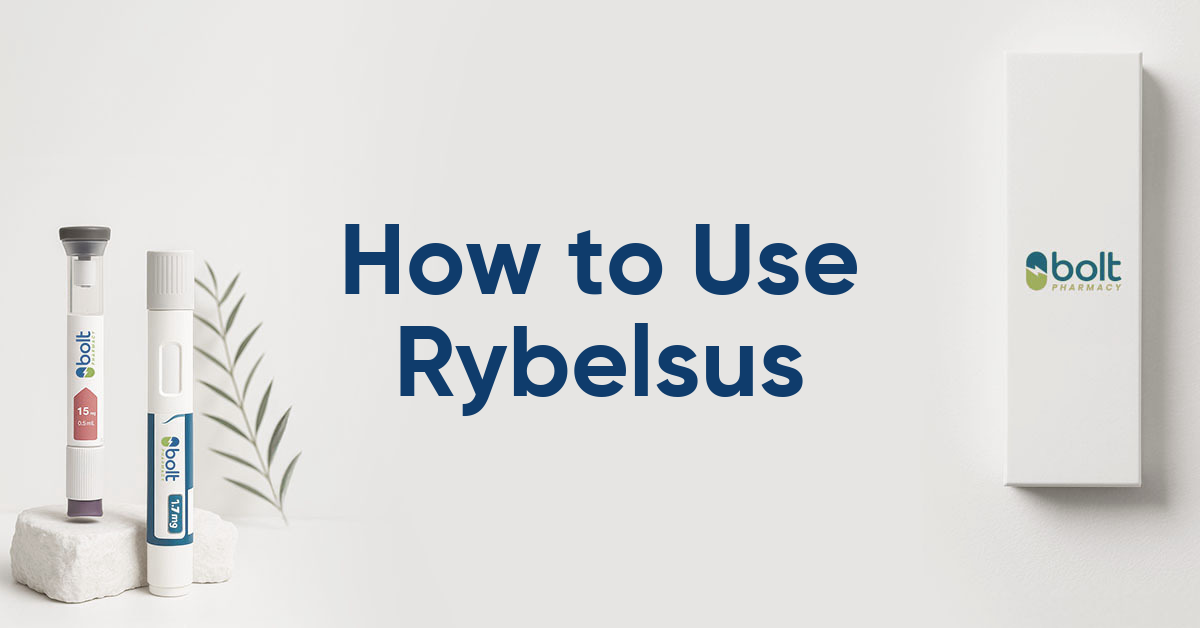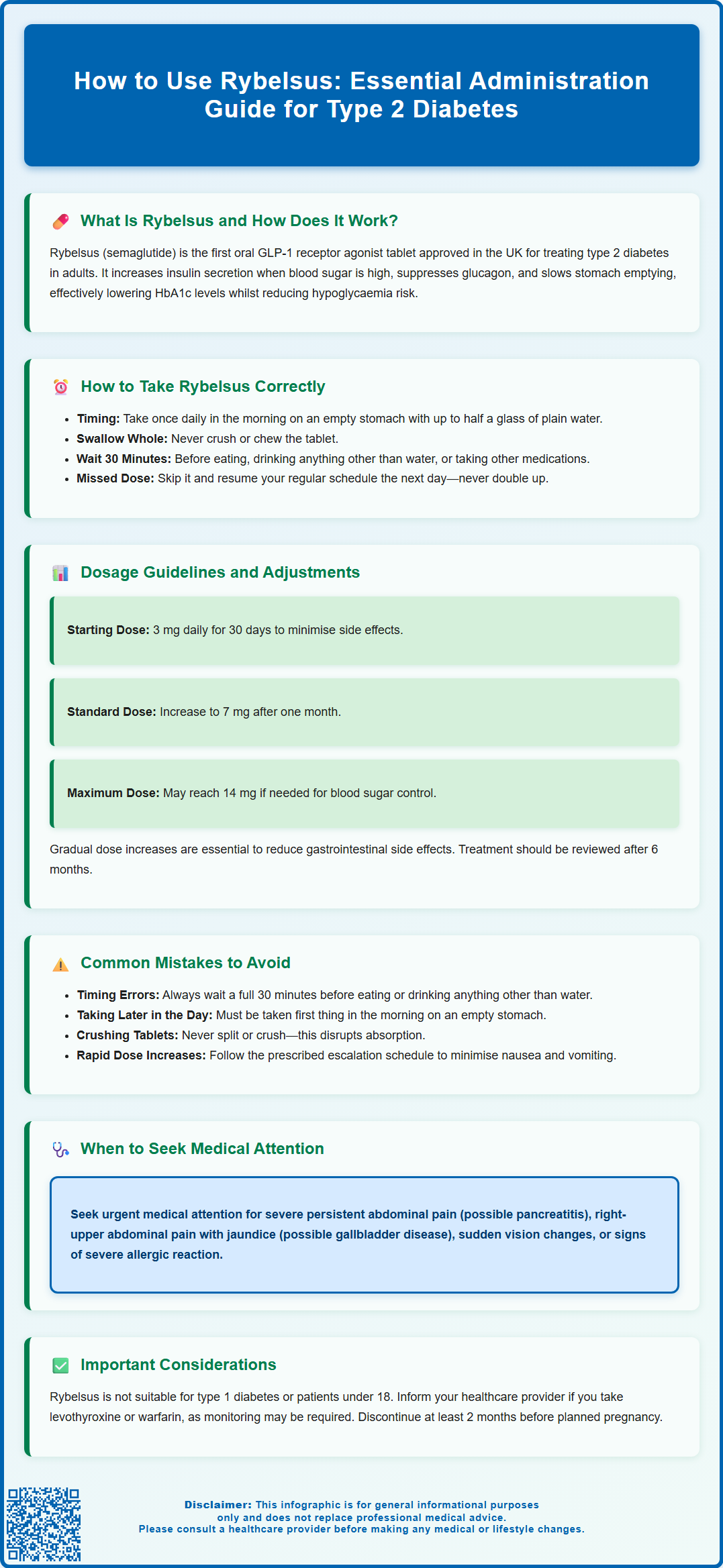Mounjaro®
Dual-agonist support that helps curb appetite, hunger, and cravings to drive substantial, sustained weight loss.
- ~22.5% average body weight loss
- Significant weight reduction
- Improves blood sugar levels
- Clinically proven weight loss

Rybelsus (semaglutide) is an oral glucagon-like peptide-1 (GLP-1) receptor agonist licensed in the UK for treating type 2 diabetes mellitus in adults. Unlike injectable GLP-1 therapies, Rybelsus offers a tablet formulation, but requires precise administration to ensure optimal absorption and effectiveness. Taking Rybelsus correctly—on an empty stomach with specific timing—is essential for achieving glycaemic control. This guide explains how to use Rybelsus properly, including dosing schedules, common mistakes to avoid, and when to seek medical advice. Understanding these requirements helps maximise treatment benefits whilst minimising side effects.
Summary: Rybelsus must be taken once daily in the morning on an empty stomach with plain water, followed by a mandatory 30-minute wait before eating, drinking anything other than water, or taking other medications.
Rybelsus (semaglutide) is an oral medication licensed in the UK for the treatment of type 2 diabetes mellitus in adults. It belongs to a class of drugs known as glucagon-like peptide-1 (GLP-1) receptor agonists. Rybelsus was the first GLP-1 receptor agonist available in tablet form, offering an alternative to injectable formulations.
The active ingredient, semaglutide, works by mimicking the action of the naturally occurring hormone GLP-1, which is released by the intestines in response to food intake. Semaglutide enhances insulin secretion from the pancreas in a glucose-dependent manner, meaning it stimulates insulin release only when blood glucose levels are elevated. This mechanism reduces the risk of hypoglycaemia compared to some other diabetes medications. Additionally, semaglutide suppresses glucagon secretion, a hormone that raises blood glucose, and slows gastric emptying, which helps to moderate post-meal blood sugar spikes and promotes satiety.
Clinical trials have demonstrated that Rybelsus effectively reduces HbA1c levels (a marker of long-term blood glucose control). Many patients may also experience weight loss, although it's important to note that Rybelsus is not licensed for weight management. The medication is typically prescribed when diet and exercise alone, or in combination with other oral antidiabetic agents such as metformin, have not achieved adequate glycaemic control. According to NICE guidance, GLP-1 receptor agonists like Rybelsus may be considered as part of a comprehensive diabetes management plan for patients who meet specific criteria.
Rybelsus is not suitable for people with type 1 diabetes or diabetic ketoacidosis and is not recommended for use in patients under 18 years of age. Caution is advised in patients with a history of pancreatitis, and monitoring is recommended for those with diabetic retinopathy, particularly when starting treatment.
Correct administration of Rybelsus is essential to ensure optimal absorption and therapeutic efficacy. Unlike most oral medications, Rybelsus has specific requirements that must be followed precisely. The tablet should be taken once daily in the morning on an empty stomach, before any food, drink (other than water), or other oral medications.
Step-by-step instructions for taking Rybelsus:
Swallow the tablet whole with a sip of plain water (up to 120 mL or half a glass). Do not split, crush, or chew the tablet, as this will affect absorption.
After taking Rybelsus, you must wait at least 30 minutes before eating, drinking anything other than water, or taking other oral medications. This waiting period is crucial because food, beverages (including tea, coffee, and juice), and other medicines can significantly reduce the absorption of semaglutide.
If you miss a dose, skip it and take your next dose the following day at the usual time. Do not take two tablets to make up for a missed dose.
If you vomit after taking Rybelsus, do not take an extra tablet. Take your next dose the following day as usual.
The unique absorption profile of oral semaglutide is due to the inclusion of an absorption enhancer (SNAC) in the formulation, which facilitates uptake across the gastric mucosa. However, this process is highly sensitive to the presence of other substances in the stomach. Patient adherence to these administration instructions is critical for achieving the desired glycaemic control.
If you are taking levothyroxine or warfarin (or other coumarin anticoagulants), inform your healthcare provider as Rybelsus may affect their levels, requiring additional monitoring. If you find the timing difficult to manage within your daily routine, discuss this with your GP or diabetes specialist nurse, who may be able to suggest strategies to help you remember or consider alternative treatment options if necessary.

Rybelsus is available in the UK in three tablet strengths: 3 mg, 7 mg, and 14 mg. The dosing regimen follows a gradual titration schedule designed to improve gastrointestinal tolerability and minimise side effects such as nausea and vomiting, which are common when initiating GLP-1 receptor agonist therapy.
Standard dosing schedule:
Starting dose: 3 mg once daily for 30 days. This initial dose is primarily intended to help your body adjust to the medication and is not expected to provide full glycaemic control.
First increase: After 30 days, the dose is increased to 7 mg once daily. Many patients achieve adequate blood glucose control at this dose.
Maximum dose: If additional glycaemic control is needed after at least 30 days on 7 mg, the dose may be increased to 14 mg once daily. This is the maximum recommended dose.
Dose adjustments should only be made under the guidance of your healthcare provider, who will consider your HbA1c levels, tolerability, and overall diabetes management goals. It is important not to increase the dose more rapidly than recommended, as this increases the likelihood of gastrointestinal side effects. If gastrointestinal symptoms persist, your doctor may delay dose escalation by at least 4 weeks or reduce the dose from 14 mg to 7 mg if not tolerated.
Special considerations:
Renal impairment: No dose adjustment is required for patients with mild to moderate kidney impairment. However, there is limited experience in patients with severe renal impairment or end-stage renal disease, so caution is advised.
Hepatic impairment: No dose adjustment is necessary for patients with liver impairment, though clinical experience in severe hepatic impairment is limited.
Elderly patients: No dose adjustment is required based on age alone, though careful monitoring is recommended in older adults.
Pregnancy and breastfeeding: Rybelsus is not recommended during pregnancy or breastfeeding. If you are planning pregnancy, Rybelsus should be discontinued at least 2 months before conception.
When used with insulin or sulphonylureas: Consider dose reduction of these medications to reduce the risk of hypoglycaemia.
Regular monitoring of blood glucose and HbA1c is essential to assess treatment response. Your GP or diabetes team will schedule follow-up appointments to review your progress and determine whether dose adjustments are appropriate. According to NICE guidance, treatment with GLP-1 receptor agonists should be reviewed after approximately 6 months and continued only if there is a clinically meaningful response in HbA1c and/or weight.
Adherence to the specific administration requirements of Rybelsus is crucial for treatment success, yet several common errors can compromise its effectiveness or increase the risk of side effects.
Taking Rybelsus with food or other medications: The most frequent mistake is not waiting the full 30 minutes after taking Rybelsus before consuming food, drinks other than water, or other oral medicines. Food or beverages like tea or coffee can markedly reduce semaglutide absorption, significantly diminishing its therapeutic effect. Set a timer or alarm to help you remember the waiting period.
Not taking Rybelsus in the morning: Rybelsus must be taken in the morning as specified in the product information. Taking it later in the day when you've already eaten will compromise absorption and effectiveness.
Crushing or splitting tablets: Some patients may be tempted to break the tablet to make it easier to swallow, but this affects the absorption mechanism that relies on the SNAC component to facilitate uptake across the gastric mucosa. If you have difficulty swallowing tablets, speak to your healthcare provider about alternative diabetes treatments.
Increasing the dose too quickly: Some patients may wish to reach the maximum dose rapidly to achieve better blood glucose control, but this significantly increases the risk of nausea, vomiting, and diarrhoea. Always follow the prescribed titration schedule.
Stopping treatment due to initial side effects: Gastrointestinal symptoms such as nausea are common when starting Rybelsus but typically improve over time as your body adjusts. If side effects are troublesome, contact your GP rather than stopping the medication abruptly, as they may be able to offer advice on managing symptoms or adjusting your treatment plan.
When to seek medical advice:
Stop Rybelsus and seek urgent medical attention if you experience severe, persistent abdominal pain (which could indicate pancreatitis).
Contact your GP if you develop right-upper abdominal pain or yellowing of the skin/eyes (possible gallbladder disease), sudden vision changes (particularly if you have diabetic retinopathy), or swelling/breathing difficulties/rash (possible allergic reaction).
Seek advice if you experience persistent vomiting or diarrhoea, and maintain adequate hydration during these episodes.
If you develop signs of hypoglycaemia (particularly if taking Rybelsus with insulin or a sulphonylurea), such as trembling, sweating, confusion, or rapid heartbeat, treat immediately with fast-acting carbohydrate and seek medical review to adjust your diabetes medications.
If you experience any suspected side effects, you can report them via the MHRA Yellow Card scheme at yellowcard.mhra.gov.uk or through the Yellow Card app.
Eating, drinking anything other than water, or taking other medications within 30 minutes of taking Rybelsus significantly reduces semaglutide absorption, compromising its effectiveness in controlling blood glucose. Always wait the full 30 minutes to ensure optimal therapeutic benefit.
No, Rybelsus must be taken in the morning on an empty stomach as specified in the product information. Taking it later in the day after eating will compromise absorption and reduce its effectiveness in managing type 2 diabetes.
The initial 3 mg dose is primarily for tolerability and not expected to provide full glycaemic control. Most patients begin to see improvements in blood glucose after increasing to 7 mg, with treatment response typically reviewed after approximately 6 months according to NICE guidance.
The health-related content published on this site is based on credible scientific sources and is periodically reviewed to ensure accuracy and relevance. Although we aim to reflect the most current medical knowledge, the material is meant for general education and awareness only.
The information on this site is not a substitute for professional medical advice. For any health concerns, please speak with a qualified medical professional. By using this information, you acknowledge responsibility for any decisions made and understand we are not liable for any consequences that may result.
Lorem ipsum dolor sit amet, consectetur adipiscing elit, sed do eiusmod tempor incididunt ut labore et dolore magna aliqua. Ut enim ad minim veniam, quis nostrud exercitation ullamco laboris nisi ut aliquip ex ea commodo consequat. Duis aute irure dolor in reprehenderit in voluptate velit esse cillum dolore eu fugiat nulla pariatur.
Block quote
Ordered list
Unordered list
Bold text
Emphasis
Superscript
Subscript